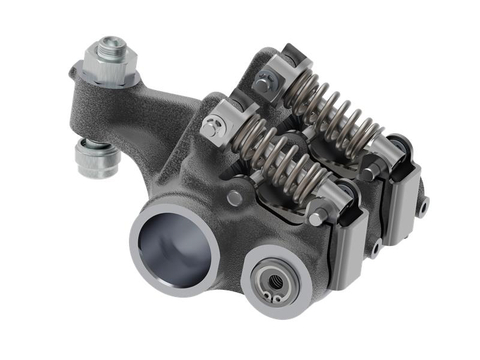
Eaton’s Variable Valve Actuation Technologies Deliver Dramatic Emissions Reductions in Recent Tests
Published by Todd Bush on March 1, 2023
GALESBURG, Mich.--(BUSINESS WIRE)--Intelligent power management company Eaton today announced its Vehicle Group's cylinder deactivation (CDA) and late intake valve closing (LIVC) technologies have been proven to simultaneously reduce nitrogen oxides (NOx) and carbon dioxide (CO2). The technologies were shown to be effective for meeting future global emissions requirements for diesel-engine powered commercial vehicles, according to a recent series of tests conducted by FEV, a recognized leader in design and development of advanced gasoline, diesel and hybrid powertrains and vehicle systems.

eaton variable valve actuator
>> In Other News: Dow and X-energy Advance Efforts to Deploy First Advanced Small Modular Nuclear Reactor at Industrial Site Under DOE’s Advanced Reactor Demonstration Program
Testing measured fuel consumption and exhaust temperature, from which engine-out NOx and CO2 were determined. Results indicated the CDA created up to a 38% reduction of NOx compared with 13% for LIVC thanks to exhaust gasses temperature increase, which enables optimal emissions aftertreatment performance. The results were delivered while simultaneously reducing CO2 emissions.
During the evaluation, the standard valvetrain on an 11-liter diesel engine was replaced with Eaton’s variable valve actuation system able to deliver either CDA or LIVC functions. The engine was put on a dynamometer and tested in standard engine and in varying CDA and LIVC engine modes to determine optimal thermal management effects and fuel savings.
“Emissions regulations are driving the adoption of variable valve actuation solutions by our global commercial vehicle customers,” said Fabiano Contarin, product director, Commercial Vehicle Valve Actuation, Eaton’s Vehicle Group. “Our portfolio of technologies is helping manufacturers meet the upcoming regulations in a number of ways based on customer preference.”
Eaton’s CDA also resulted in a 3% decrease in fuel consumption in a low-load cycle, while LIVC lowered fuel consumption by 0.5%. Additionally, CDA in three-cylinder mode raised exhaust temperatures up to 175 degrees Celsius which helped increase the efficiency of a selective catalytic reduction (SCR) system.
The study results confirm earlier findings of tests conducted in the U.S. by Eaton and the Southwest Research Institute (SwRI), one of the oldest and largest independent, nonprofit applied research and development organizations. The findings of the U.S.-based tests found using CDA and a close-coupled selective catalytic reduction (SCR) catalyst reduced CO2 emissions by 4% in a low load cycle with NOx emission of 0.02 g/hp-hr.
“If a low-load cycle is a customer’s focus, then CDA is the ideal technology,” Contarin said. “LIVC, instead, provides lower benefits but in a wider range of the engine map, especially when combined with a higher compression ratio.”
Learn more about Eaton’s variable valve actuation solutions.
Eaton is an intelligent power management company dedicated to improving the quality of life and protecting the environment for people everywhere. We are guided by our commitment to do business right, to operate sustainably and to help our customers manage power ─ today and well into the future. By capitalizing on the global growth trends of electrification and digitalization, we’re accelerating the planet’s transition to renewable energy, helping to solve the world’s most urgent power management challenges, and doing what’s best for our stakeholders and all of society.
Founded in 1911, Eaton is marking its 100th anniversary of being listed on the New York Stock Exchange. We reported revenues of $20.8 billion in 2022 and serve customers in more than 170 countries. For more information, visit www.eaton.com. Follow us on Twitter and LinkedIn.
Contacts
Thomas Nellenbach
thomasjnellenbach@eaton.com
(216) 333-2876 (cell)
Subscribe to the newsletter
Daily decarbonization data and news delivered to your inbox
Follow the money flow of climate, technology, and energy investments to uncover new opportunities and jobs.
Latest issues
-
SAF Output Doubled, So Why Is IATA Sounding Alarms?
Happy New Year from Decarbonfuse! As we wrap up 2025, we want to thank you for being part of the growing Decarbonfuse community. Your engagement and feedback have helped make this platform a trust...
-
$213 Per Tonne: Inside the Latest Multi-Pathway CDR Deal
Inside This Issue 💸 $213 Per Tonne: Inside the Latest Multi-Pathway CDR Deal 🏛️ Clean Energy Technologies Affiliate Vermont Renewable Gas Advances Regulatory Review 💧 Fusion Fuel’s BrightHy Soluti...
-
The Three-Continent Move That Redefines SAF
Wishing everyone a restful holiday season.🎄🎅🎁 Inside this Issue ✈️ Cathay Goes Global With SAF in Three-Continent Fuel Deal 🧪 Proton Ventures Partners With Barents Blue For Realization Of The Bar...
Company Announcements
-
HyOrc Completes Factory Acceptance Test of 500kW ORC Turbine for International Customer
HOUSTON, Dec. 31, 2025 (GLOBE NEWSWIRE) -- HyOrc Corporation (OTCID: HYOR), a clean-energy technology company, today announced the successful completion of the Factory Acceptance Test (FAT) for its...
-
Nova Sustainable Fuels Receives Approval to Produce Sustainable Aviation Fuel in Guysborough County
Nova Sustainable Fuels has received environmental assessment approval for the first phase of a project that will see the company develop a renewable energy park in Goldboro, Guysborough County, whe...
-
Darling Ingredients Announces Sale of Approximately $50 Million in Production Tax Credits
IRVING, Texas -- Darling Ingredients Inc. (NYSE: DAR) today announced the sale of approximately $50 million of production tax credits to a corporate buyer. These credits were generated under the In...
-
Aemetis Receives Funds From the Sale of $17 Million of Federal Clean Energy Tax Credits
CUPERTINO, Calif., Dec. 30, 2025 (GLOBE NEWSWIRE) -- Aemetis, Inc. (NASDAQ: AMTX), a renewable natural gas and renewable liquid fuels company focused on lower cost and reduced emissions products, t...